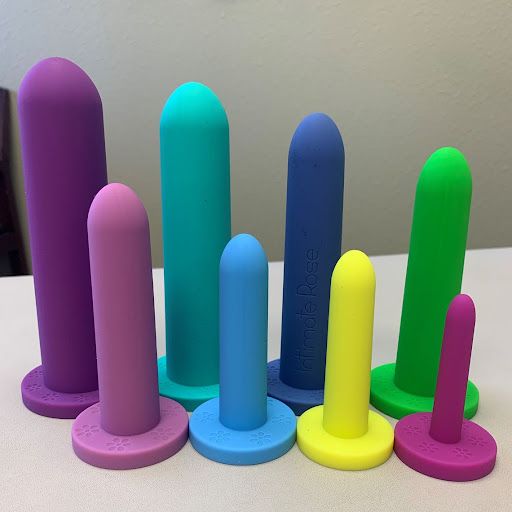Pelvic Floor Physical Therapy is a specialized field practiced by clinicians who have undergone unique training and education. Similarly, practitioners utilize unique tools and techniques to serve their patients. Below are some of the more common tools and equipment your pelvic floor physical therapist might incorporate or suggest during your treatment.
Dilators
Vaginal or rectal dilators are medical device tools used for anyone who suffers from pain with insertion or with sexual activity, vaginal narrowing, vaginal atrophy, or other medical conditions such as limitations from scar tissue. Vaginal and rectal dilators are cylinder-shaped tools made of silicone or hard plastic that come in different sizes and allow people to safely and progressively stretch the vagina or rectum. A pelvic floor physical therapist can help you determine if dilators are right for you, figure out what size to start with and how to progress, and instruct you on safe and effective use of dilator therapy.
Pelvic Wands
Just like you can get tight, tender “knots” in other muscles on your body, your pelvic floor muscles can also develop taut bands (known as trigger points) that contribute to pain or dysfunction. Pelvic wands are a great tool to alleviate pain and symptoms associated with trigger points. They can be inserted into the vagina or rectum and have a curved, “S” shape that allows people to work on deeper or more difficult-to-access spots within the pelvic floor muscles.
Biofeedback Tools & Vaginal Trainers
Biofeedback refers to utilizing a tool that provides real-time feedback on your body’s function, helping to improve awareness and control of your body. It may include devices such as vaginal trainers like the Perifit and Elvie, or external sensors your physical therapist places to then convert pelvic floor muscle activity to visual or audio real-time information. Biofeedback does not have to mean fancy equipment – even a handheld mirror can provide invaluable information about how your body, and pelvic floor muscles specifically, are functioning.
Cupping Sets
Cupping sets may be silicone, plastic, or glass and are used to create a suction effect, or negative pressure over the skin to create myofascial decompression. They can be an excellent tool to improve circulation and lymphatic flow, improve flexibility, and treat scar tissue such as from abdominal incisions or Cesarean section scars.
Vaginal Weights
Vaginal weights are designed to strengthen and provide awareness to the pelvic floor muscles and may be used for conditions such as improving bladder control, managing pelvic organ prolapse, and improving sensation with intimacy. They come in progressively heavier sizes and can be a great way to progress functional pelvic floor muscle strength with specific exercises and activities. Note that if you have extra tension in your pelvic floor muscles, the use of vaginal weights may make your condition worse, so it is important to consult with a pelvic health physical therapist to see if you are a good candidate for vaginal weights.
Lube, Lube, and More Lube
Whether focusing on hands-on treatments or utilizing a device, your pelvic floor physical therapist will always use a generous amount of lubrication for all internal treatments!
Traditional Physical Therapy & Exercise Equipment
The mechanics and function of your pelvis and pelvic floor muscles work alongside your hips and trunk and are greatly influenced even by your feet, and pelvic floor physical therapy treatment often includes exercises for multiple body regions that contribute to pelvic floor dysfunction. Traditional physical therapy and exercise equipment such as myofilament needles for trigger point dry needling, bands, weights, Pilates rings, suspension trainers, foam rollers, and stability balls may be utilized directly in relation to your pelvic floor or for other body regions contributing to your issues.

